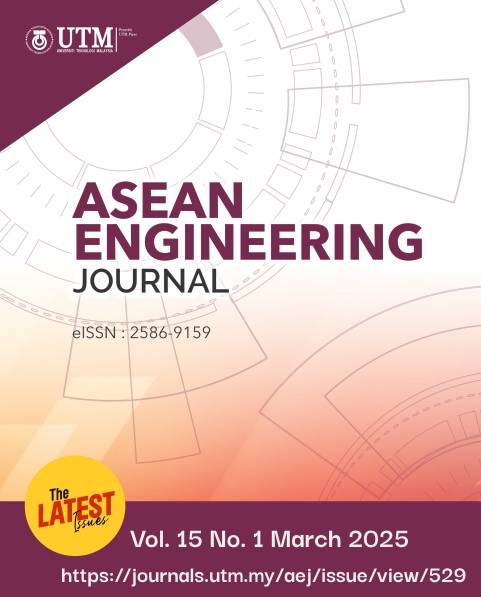EXPERIMENTAL AND FINITE ELEMENT ANALYSIS OF BENDING TEST OF GIGANTOCHLOA ATROVIOLACEA (WULUNG BAMBOO): LINEAR-ISOTROPIC MATERIAL USING BENDING PROPERTIES
DOI:
https://doi.org/10.11113/aej.v14.20653Keywords:
wulung bamboo, flexural test, finite element analysis, prismatic isotropic linear, bending propertiesAbstract
Predicting the flexural behavior of bamboo beams is challenging due to their complex shape and disparate material properties. This study evaluates the accuracy of numerical analysis in predicting bamboo flexural behavior, utilizing a homogeneous bamboo diameter approach and applying the flexural modulus of elasticity property. Wulung bamboo was used for the bending experiment, following ISO 22157:2019. Finite element analysis was conducted using Abaqus CAE software. The numerical results were compared with experimental results including deflection, neutral axis position, strain, and stress. Results indicate that numerical modeling of a bamboo beam can predict Wulung bamboo's linear deformation, with a 2.03% discrepancy. The neutral axis from numerical analysis deviates by 3.43 mm and 6.69 mm above experimental measures under elastic and ultimate loads, respectively. The numerical analysis bamboo beam model shows closer results in predicting the compressive strain than predicting the tensile strain of a bamboo beam. The difference in maximal compressive strain on the topmost surface between numerical analysis and experimental results ranges from 1.92% to 15.1%. The difference in maximal tensile strain on the bottommost surface between numerical analysis and experimental results ranges between 16.1% and 24.3 %. The maximum normal stress ratio to modulus of rupture is 0.995.
References
Abdullah A.H.D., Karlina N., Rahmatiya W., Mudaim S., Patimah, and Fajrin A. R. 2017. Physical And Mechanical Properties Of Five Indonesian Bamboos. IOP Conference Series: Earth and Environmental Science. 1-5. DOI: 10.1088/1755-1315/60/1/012014
Ma’Ruf M. F. 2017. A Review on the Use of Bamboo for Earthwork Construction. MATEC Web Conference, The 6th International Conference of Euro Asia Civil Engineering Forum. 1-8. DOI: 10.1051/matecconf/201713804010
Tiza T.M., Singh S. K., Kumar L., Shettar M. P., and Singh S. P. 2021. Assessing The Potentials Of Bamboo And Sheep Wool Fiber As Sustainable Construction Materials: A Review. Material Today Proceeding. 4484–4489. DOI: 10.1016/j.matpr.2021.05.322.
International Standard Organization ISO-22156. 2021. International Standard Bamboo structures — Bamboo culms — Structural design. Switzerland.
Eratodi I. G. L. B. 2017. Struktur dan Rekayasa Bambu. Denpasar, Bali: Universitas Pendidikan Nasional Denpasar Bali.
Chaowana K., Wisadsatorn S., and Chaowana P. 2021. Bamboo As A Sustainable Building Material—Culm Characteristics And Properties. Sustainability.1-18. DOI: https://doi.org/10.3390/su13137376
Akinbade Y., Nettleship I., Papadopoulos C., and Harries K. A. 2021. Modelling Full-Culm Bamboo As A Naturally Varying Functionally Graded Material. Wood Science Technology. 155–179. DOI: 10.1007/s00226-020-01246-6.
Oka G. M., Triwiyono A., Awaludin A., and Siswosukarto S. 2014. Effects Of Node, Internode And Height Position On The Mechanical Properties Of Gigantochloa Atroviolacea Bamboo. Procedia Engineering, 2nd International Conference on Sustainable Civil Engineering Structures and Construction Materials. 31 37. DOI: 10.1016/j.proeng.2014.12.162.
Candelaria M. D. E. and Hernandez J. Y. 2019. Determination of the Properties of Bambusa Blumeana Using Full-Culm Compression Tests and Layered Tensile Tests for Finite Element Model Simulation Using Orthotropic Material Modeling. ASEAN Engineering Journal. 54–71. DOI: 10.11113/aej.v9.15508.
Suriani E. 2020. A Study of the Physical-Mechanical Properties of Bamboo in Indonesia. Proceedings of the Built Environment, Science and Technology International Conference. 154–162. DOI: 10.5220/0008904601540162.
Siopongco M., J.O.; Munandar. 1987. Technology Manual On Bamboo As Building Material. Forest Products Research and Development Institute.
Sato M., Inoue A., and Shima H. 2017. Bamboo-Inspired Optimal Design For Functionally Graded Hollow Cylinders. PLoS ONE. 1–14. DOI: https://doi.org/10.1371/journal.pone.0175029
Tan T. et al. 2011. Mechanical Properties Of Functionally Graded Hierarchical Bamboo Structures. Acta Biomaterial. 3796–3803. DOI: 10.1016/j.actbio.2011.06.008.
Irawati I. S. and Wusqo U. 2020. Perbandingan Perilaku Lentur Balok Bambu Menggunakan Sifat Mekanik yang Diperoleh dengan Metode Rata-rata dan Persentil ke-5. Jurnal Permukiman. 1–23. DOI: https://doi.org/10.31815/jp.2020.15.43-53
Ramful R. and Sakuma A. 2020. Investigation Of The Effect Of Inhomogeneous Material On The Fracture Mechanisms Of Bamboo By Finite Element Method. Materials (Basel). 1–15 DOI: 10.3390/ma13215039.
Abzarih A. W., Irawati I. S., and Suhendro B. 2022. Nonlinear Numerical Model of Glued-Laminated Petung Bamboo Under Flexural Test Based on ASTM D 143-94. Proceeding 5th International Conference Sustainable Civil Engineering Structures Construction Material. DOI: 10.1007/978-981-16-7924-7.
Junaid A., Irawati I. S., and Awaludin A. 2022. Analisis Sifat Mekanis dan Fisis Bambu Menggunakan Metode Destruktif. Jurnal Teknik Sipil MACCA. 41–49. DOI: https://doi.org/10.33096/jtsm.v7i1.540
Nurmadina, Nugroho N., and Bahtiar E. T. 2017. Structural Grading Of Gigantochloa Apus Bamboo Based On Its Flexural Properties. Construction Building Material. 1173–1189. DOI: 10.1016/j.conbuildmat.2017.09.170.
Bahtiar E. T., Imanullah A. P., Hermawan D., Nugroho N., and Abdurachman. 2019. Structural grading of three sympodial bamboo culms (Hitam, Andong, and Tali) subjected to axial compressive load. Engineering Structures. 233 245. DOI: 10.1016/j.engstruct.2018.12.026.
Firdaus A., Prastyatama B., Sagara A., and Wirabuana R. N. 2017. Deployable bamboo structure project: A building life-cycle report. AIP Conference Proceeding. 1-7. DOI: 10.1063/1.5011509.
Fitrianto A. 2015. Bamboo architecture for sustainable communities. Parahyangan Bamboo Nation 2. 1-8.
Awaludin A. and Andriani V. 2014. Bolted bamboo joints reinforced with fibers. Proceeding 5th International Conference Sustainable Civil Engineering Structures Construction Material. 15–21. DOI: 10.1016/j.proeng.2014.12.160.
Taufani A. R. and Nugroho A. S. B. 2014. Proposed bamboo school buildings for elementary schools in Indonesia. Proceeding 5th International Conference Sustainable Civil Engineering Structures Construction Material.5–14. DOI: 10.1016/j.proeng.2014.12.159.
International Standard Organization ISO-22157. 2019. International Standard Bamboo structures — Determination of physical and mechanical properties. Switzerland
Willam KJ. 2002. Constitutive Models For Engineering Materials. Encyclopedia of Physical Science and Technology. 603–633.
Shames I. H. 2020. Linear Elastic Behavior Elastic And Inelastic Stress Analysis. 147–176. DOI: 10.1201/b16599-8
Li H. T., Deeks A. J., Zhang Q. S., and Wu G. 2016. Flexural Performance Of Laminated Bamboo Lumber Beams. BioResources. 929–943. DOI: 10.15376/biores.11.1.929-943.
















